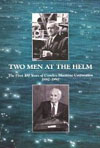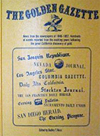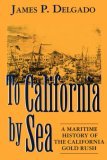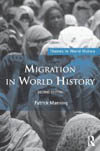Passengers at the Port of San Francisco: 1800s

Thomas O. Larkin
Thomas O. Larkin was born in Charlestown, Mass on September 16, 1802.
Early businesses took his health and hard-earned wealth, so Larkin decided to locate his half-brother, John B. R. Cooper, who had married into California's Vallejo family. He obtained space on the Newcastle, Captain Hersey, bound to the Pacific coast in search of markets. She left Boston in September 1831, arrived at the Sandwich Islands in February 1832, then in San Franciscoin April 1832.
Mr. Larkin stayed aboard, and found his brother when then sailed into Monterey.
In 1833, Larkin was married on board of an American ship on the coast of California by John C. Jones, U. S. consul of the Sandwich Islands. His wife, from Massachusetts, was the first lady from the United States to settle in California. He began exporting timber, lumber, singles, flour, potatoes, soap, beaver and otter skins, and horses to the Sandwich Islands, Mazatlan and Acapulco.
In 1844, Larkin was appointed U.S. consul for California -- the first and last American consul ever appointed in the country.
Larkin is greatly responsible for bringing the American flag to California-- he literally assisted in hoisting the national flag in four difference places.
Californian, July 3, 1847
DEED FOR BENICIA CITY, FROM M. G. VALLEJO, TO SEMPLE AND LARKIN.
(Translation)
In the Town of Sonoma, Upper California, this nineteenth day of the month of May, one thousand eight hundred and forty-seven.
I, Mariano G. Vallejo, resident of this jurisdiction and lawful owner of ihe estate known by the name of Soscol in this district, by these presents do declare in my own name, and in the name of my heirs, administrators and others, who through them may have any voice and cause, that I cede and transfer freely, and spontaneously in favor of Don Thomas O. Larkin and Don Robert Semple, for them, their heirs and successors, and whoever through them may have any title, voice and cause, for ever and ever, five miles of land in the said estate of Soscol, in the Straits of Carquinez Bay of San Francisco, according to the measurement, made by Don Jasper O'Farrell, which is as follows:
Beginning at a stone marked RS, and running North seventy-six degrees West to a corner or angle, five English miles; from thence in the direction of South fourteen degrees West to another angle; one mile, thence South seventy-six degrees East to the Bay of the Straits, three quarters of a mile, or one mile a little more or less thence following the sinuosities of the Bay of the Straits to the place where the measurment commenced, which altogether makes an extent of five English miles, following the turns of tho Bay and the sinuosities of the land according to theo measurment and plan made by Don Jasper O'Farrell, Surveyor.
The said place with all its entrances outlets and rights, I cede, transfer and bestow to the before-mentioned Don Thomas O. Larkin, and Don Robert Semple, by way of donation, pure, perpetual and hereditary, that they may enjoy it freely, by virtue of the rights granted to them by these presents, guaranteeing to them the ownership thereof for ever, against whatever reclamations may occur they agreeing to, and strictly fulfilling the following conditions.
1st. ? The said Don Thomas O. Larkin and Don Robeit Semple, oblige and bind themselves, in the most solemn manner, and under the legal guarantees to found a city; which shall be called Francisca, or Benicia on the said land, and divide it into lots for houses, to be disposed of by sale or otherwise as soon as they can obtain purchasers, and in the course of the present year they shall establish at said place, means of conveyance (ferry boats) to pass from one side of the straits to the other, passengers, carriages, &.c.
2nd. ? As soon as the city contains one hundred families, a magistrate or municipal authority shall be named for the administration of justice, and the ferry boats, together with the landing places shall belong to the town, and their products destined for the establishment of public schools for the benefit of the families who colonize said city.
3rd. ? Until the hundred families and the municipal authorities mentioned in the proceeding article be established, the ferry boats and their products shall belong to Don Robert Semple.
In proof and testimony of the mutual agreement of all and each of the contracting parties, they signed these presents in triplicate in the said town, day, month and year, in presence of the Alcalde of the jurisdiction, Don L. W . Boggs, and the undersized witnesses.
(Signed,)
M. G. VALLEJO
R. SEMPLE.
T. O. LARKIN.
Witnesses
J. P. LEESE.
VOR. PRUDON.
Territory of California, District of Sonoma
Personally appeared before me, the undersigned, Alcalde of the District of Sonoma, Don Mariano G. Vallejo, Thomas O. Larkin and R. Semple, all being personally known to me to be the persons whose names are subscribed to the above instrument of writing and acknowledged the same to be their act and deed for the purposes therein mentioned. Given under my hand and private's* al, at the office in Sonoma, this 19th day of May, 1847.
(Signed,) LILBURN W. BOGGS, [Seal]
The foregoing as far as thus mark J is a correct translation, and the remainder, a true and faithful copy of the original document, presented to me by T. O. Larkin.
W. E. P. HARTNELL, Government Translator.
In July of 1853, along with Samuel Brannan, he was elected to office inthe "Society of California Pioneers."
Brannan was elected President, and Thomas O. Larkin was a Vice President.
The Annals of San Francisco
Frank Soule, John H. Gihon, Jim Nisbet. 1855.
Written by three journalists who were witnesses to and participants in the extraordinary events they describe. The Annals of San Francisco is both an essential record for historians and a fascinating narrative for general readers. Over 100 historical engravings are included. Partial Contents: Expeditions of Viscaino; Conduct of the Fathers towards the natives; Pious Fund of California; Colonel John C. Fremont; Insurrection of the Californians; Description of the Golden Gate; The Presidio of San Francisco; Removal of the Hudson's Bay Company; Resolutions concerning gambling; General Effects of the Gold Discoveries; Third Great Fire; Immigration diminished; The Chinese in California; Clipper Ships; Increase of population; and Commercial depression.

Two Men at the Helm: The First 100 Years of Crowley Maritime Corporation, 1892-1992
Jean Gilbertson.
Crowley Maritime started as a one-man operation, with nothing more than one 18-foot Whitehall rowboat to provide transportation of personnel and stores to ships anchored on San Francisco Bay. In the mid-1800s, the business was incorporated under the name Thomas Crowley and Brothers. Withing a few years, services grew to include bay towing and ship-assist services. By the turn of the century, Crowley's expansion continued by operating small barges to transport steel to Oakland and barrels of oil, ice, and other supplies to ships in San Francisco Bay. In July 1902, the San Francisco Call reported "The new launch Guide, owned by Thomas Crowley & Bros., made her first trip yesterday to the Farallon Islands and carried out her builders' highest anticipations. By 1912, Crowley had built a marine railway, dock and woodworking mill. Growth continues to this day.
A History of California
Franklin Tuthill.
This comprehensive 19th century history of California, from its early times up to the Gold Rush was written "because there seemed to be a demand for a History of California which should sketch the main events of the country from its discovery to the present time. Beginning with Spanish priests, who enslaved indigenous tribes, millions rushed in and claimed the land after the Gold Rush. The material is abundant: log-books of ancient mariners; archives of the Government while the territory was under Spanish or Mexican rule; official reports and Congressional documents about the transfer to the United States; files of newspapers; scores of books of intelligent travellers; the oral evidence of natives, and early immigrants." These sources were the base materials for this publication.
When America First Met China:
An Exotic History of Tea, Drugs, and Money in the Age of Sail
Eric Jay Dolin.

to the The Glorious Reign of Emperor Qianlong: Splendors of China's Forbidden City, who considered foreigners inferior beings -- this saga of pirates and politicians, coolies and concubines becomes a must-read for any fan of Nathaniel Philbrick's Mayflower
or Mark Kurlansky's Cod.
Two maps, 16 pages of color, 83 black-and-white illustrations.
Atlantis: The Antediluvian World
Ignatius Donnelly.
The author and politician Ignatius Donnelly was born in Philadelphia on 3 November 1831. He was educated in the public schools of his native city, studied law, was admitted to the bar, and practiced. He went to Minnesota in 1857, was elected lieutenant governor in 1859, and again in 1861, and was then elected to Congress as a Republican, serving from 7 December 1863 until 3 March 1869. Besides doing journalistic work he has written an Essay on the Sonnets of Shakespeare, and his most enduring work, Atlantis, the Antediluvian World (New York, 1882), in which he attempts to demonstrate that there once existed in the Atlantic Ocean, opposite the straits of Gibraltar, a large island, known to the ancients as "Atlantis"; and Ragnarok (1883), in which he tries to prove that the deposits of clay, gravel, and decomposed rocks, characteristic of the drift age, were the result of contact between the earth and a comet.








 Copyright ~ 1998-2018.
Copyright ~ 1998-2018. 